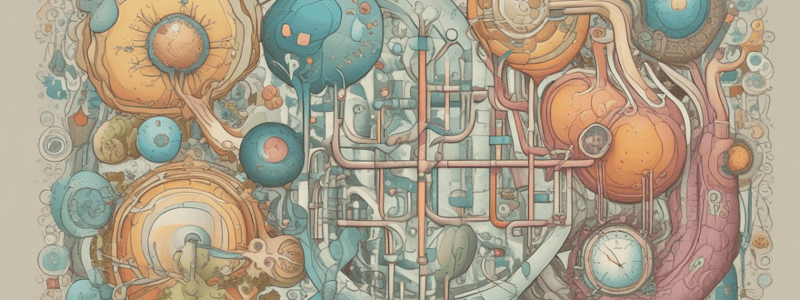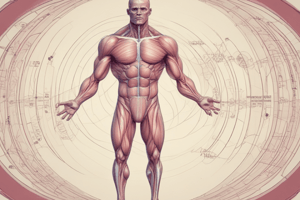Podcast
Questions and Answers
What is the end product of glycolysis?
What is the end product of glycolysis?
- AcetylCoA
- Glucose
- NADH
- Pyruvate (correct)
Which process regenerates NAD+ in anaerobic conditions?
Which process regenerates NAD+ in anaerobic conditions?
- Glycogenesis
- Oxidative phosphorylation
- Cori Cycle (correct)
- Krebs Cycle
What is the purpose of the Cori Cycle during exercise?
What is the purpose of the Cori Cycle during exercise?
- To release carbon dioxide
- To increase oxygen intake
- To convert lactate into glucose (correct)
- To produce energy in the form of ATP
Which molecule is NOT directly involved in the Krebs Cycle?
Which molecule is NOT directly involved in the Krebs Cycle?
What is the net loss of ATP in the Cori Cycle if you include the ATP made in glycolysis?
What is the net loss of ATP in the Cori Cycle if you include the ATP made in glycolysis?
Which metabolic pathway converts glucose to glycogen for storage?
Which metabolic pathway converts glucose to glycogen for storage?
Which metabolic pathway describes the conversion of lactate produced by anaerobic glycolysis in muscles to glucose in the liver?
Which metabolic pathway describes the conversion of lactate produced by anaerobic glycolysis in muscles to glucose in the liver?
In anaerobic conditions, what is the fate of pyruvate in red blood cells?
In anaerobic conditions, what is the fate of pyruvate in red blood cells?
Which process makes NADH available for further ATP production in glycolysis in red blood cells?
Which process makes NADH available for further ATP production in glycolysis in red blood cells?
What is the primary energy production pathway for red blood cells under normal conditions?
What is the primary energy production pathway for red blood cells under normal conditions?
In the Cori cycle, what role does the liver play in glucose metabolism?
In the Cori cycle, what role does the liver play in glucose metabolism?
What is the key process that allows red blood cells to produce ATP in the absence of oxygen?
What is the key process that allows red blood cells to produce ATP in the absence of oxygen?
What is the significance of branching in glycogen synthesis?
What is the significance of branching in glycogen synthesis?
During which conditions is glycogenesis activated?
During which conditions is glycogenesis activated?
What is the role of glycogenin in glycogenesis?
What is the role of glycogenin in glycogenesis?
What is the byproduct of glycolysis that is used in glycogenesis?
What is the byproduct of glycolysis that is used in glycogenesis?
What is the purpose of glycogen storage?
What is the purpose of glycogen storage?
In which cells does glycogenesis occur?
In which cells does glycogenesis occur?
During which process is lactate converted back to glucose in the liver?
During which process is lactate converted back to glucose in the liver?
What is the primary purpose of converting pyruvate into lactate in the cell?
What is the primary purpose of converting pyruvate into lactate in the cell?
In which cells does the process of turning glucose into lactate primarily occur?
In which cells does the process of turning glucose into lactate primarily occur?
Which of the following statements best describes the role of glycolysis in cellular metabolism?
Which of the following statements best describes the role of glycolysis in cellular metabolism?
What happens to the excess lactate produced in patients with renal failure, according to the text?
What happens to the excess lactate produced in patients with renal failure, according to the text?
How many net ATP are lost in the Cori Cycle before the carbon chain enters regular aerobic metabolism?
How many net ATP are lost in the Cori Cycle before the carbon chain enters regular aerobic metabolism?
What is the first step in converting glucose into energy?
What is the first step in converting glucose into energy?
Which process maximizes the energy potential of glucose during anaerobic conditions?
Which process maximizes the energy potential of glucose during anaerobic conditions?
What describes the storage and release of glucose in the body?
What describes the storage and release of glucose in the body?
Which enzyme traps glucose inside the cell via phosphorylation?
Which enzyme traps glucose inside the cell via phosphorylation?
What molecule regulates the entry of glucose into the cell?
What molecule regulates the entry of glucose into the cell?
What process involves the reduction of NAD+ to NADH?
What process involves the reduction of NAD+ to NADH?
Flashcards
Glycolysis
Glycolysis
The process that converts glucose into pyruvate, generating ATP and NADH.
Pyruvate
Pyruvate
The end product of glycolysis, a three-carbon molecule that can be further oxidized.
Cori Cycle
Cori Cycle
The metabolic pathway that regenerates NAD+ in anaerobic conditions by converting lactate back to glucose.
Glycogenesis
Glycogenesis
Signup and view all the flashcards
Glycogenolysis
Glycogenolysis
Signup and view all the flashcards
Hexokinase
Hexokinase
Signup and view all the flashcards
Insulin
Insulin
Signup and view all the flashcards
Lactate Dehydrogenase Reaction
Lactate Dehydrogenase Reaction
Signup and view all the flashcards
Glycolysis
Glycolysis
Signup and view all the flashcards
Gluconeogenesis
Gluconeogenesis
Signup and view all the flashcards
Glycogen
Glycogen
Signup and view all the flashcards
Fermentation
Fermentation
Signup and view all the flashcards
Lactate
Lactate
Signup and view all the flashcards
Branching in Glycogen Synthesis
Branching in Glycogen Synthesis
Signup and view all the flashcards
Glycogenin
Glycogenin
Signup and view all the flashcards
Glucose-6-phosphate
Glucose-6-phosphate
Signup and view all the flashcards
Glycogenesis
Glycogenesis
Signup and view all the flashcards
Pyruvate to Lactate Conversion
Pyruvate to Lactate Conversion
Signup and view all the flashcards
Glucose-6-phosphatase
Glucose-6-phosphatase
Signup and view all the flashcards
Glycogenesis
Glycogenesis
Signup and view all the flashcards
Cori cycle
Cori cycle
Signup and view all the flashcards
Glycogen Storage
Glycogen Storage
Signup and view all the flashcards
Glycogenolysis
Glycogenolysis
Signup and view all the flashcards
Glycogenolysis
Glycogenolysis
Signup and view all the flashcards
Cori Cycle ATP Loss
Cori Cycle ATP Loss
Signup and view all the flashcards
Lactate Accumulation in Renal Failure
Lactate Accumulation in Renal Failure
Signup and view all the flashcards
Glycolysis
Glycolysis
Signup and view all the flashcards
Study Notes
Glycolysis and the Cori Cycle
- Lactate is produced to allow muscle cells to access NAD+ and continue glycolysis to provide ATP.
- The Cori Cycle ensures that ATP-rich glucose is not lost as a waste product (lactate) but can be recycled for use by the muscle in aerobic metabolism.
- The Cori Cycle shows a net loss of 8 ATP, but a net gain once the carbon chain leaves the Cori Cycle and enters into regular aerobic metabolism.
Lactate and Glucose
- Lactate is produced in anaerobic conditions, such as in exercising muscle and red blood cells, to regenerate NAD+ for further ATP production in glycolysis.
- The Cori Cycle transports lactate from muscles to the liver, where it is converted back to glucose through gluconeogenesis.
- Glucose can be stored as glycogen during glycogenesis and broken down into glucose when needed by muscles or for release into the blood stream.
Regulation of Glycolysis
- ATP is made in small quantities, and glucose is stored as glycogen.
- Fatty acids are stored as triglycerides, and amino acids are used to make proteins.
- High glucose levels react with protein, requiring safe storage.
- Glycogenesis is activated during rest and when insulin signals excess glucose.
Glycogenesis
- Glycogenesis stores glucose by creating glycogen in muscle cells and the liver.
- A core protein of glycogenin is surrounded by branches of glucose units.
- Glycogen synthase and glycogen branching enzyme are involved in the process.
- Branching allows multiple points of access to glucose molecules.
Cellular Metabolism
- Glycolysis is the first step in converting glucose to energy.
- The Cori Cycle maximizes energy potential in anaerobic conditions.
- Glycogenesis and glycogenolysis describe glucose storage and release in the body.
- The Krebs cycle and electron transport chain continue the conversion of glucose into energy.
Studying That Suits You
Use AI to generate personalized quizzes and flashcards to suit your learning preferences.
Related Documents
Description
Explore the processes of glycolysis, Cori cycle, glycogenesis, glycogenolysis, Krebs cycle, and cellular metabolism. Understand how glucose is converted into ATP to power our cells, and how energy potential is maximized under anaerobic conditions.




